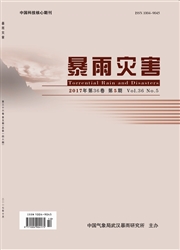

 中文摘要:
中文摘要:
使用常规观测资料及GFS资料(1°×1°),选取2005--2008年汛期22次湖北省强降水天气过程,按照其影响系统分为低槽型、台风型和副高外围型三类,对GRAPES模式(2.1版本)预报效果进行分类检验分析,结果表明:(1)就低槽型降水而言,0-24h预报时效内,模式对晴雨、小雨、大雨的预报效果在三类降水中最好,24—48h则中雨预报效果最好.0~24h预报效果总体而言优于24~48h。模式预报的主要降水区从雨型、雨区范围和雨强的分布特征均与实况较为一致.预报的主要偏差在于强中心位置偏离和强度偏弱。(2)就台风型降水而言,0~24h预报时效内,模式对中雨和暴雨的预报效果在三类降水中最好,24~48h,则晴雨、小雨、大雨、暴雨预报效果最好,24~48h预报效果总体而言优于0,24h。模式对台风的主体降水落区把握得比较好,和实况较为一致,但对于台风外围云系产生的降水往往与实况差别较大,另外,主体降水中暴雨落区预报总是比实况偏小。(3)副高外围型降水在上述两个预报时次中,各量级的评分成绩均为最低,0~24h预报效果总体而言优于24—48h。模式对副高外围局地性强降水过程预报能力较弱,基本不具备预报中雨以上降水的能力。最后对GRAPES模式的进一步改进提出了一些建议。
 英文摘要:
英文摘要:
Twenty-two heavy rain events are classified into three types by different governing weather systems to evaluate the model ability in predicting heavy rain events over HuBei Province using Grapes V2.1, observation data and GFS data (1°×1°). The results show: (1) Precipitation by trough has a highest Ts score in fine, rainfall between 0 mm and 10 mm and rainfall between 25 mm and 50 mm in the period from 0 to 24 h. It also has a highest Ts score in rainfall between 10mm and 25 mm in the period from 24 to 48 h. Ts score of 0-24 h is better than that of 24-48 h. The main errors come from the deviation of heavy rain center and a lighter quantity.(2) Precipitation by typhoon has a highest Ts score in rainfall between 10 mm and 25 ram, and rainfall more than 50 mm in the period from 0 to 24 h. It also has a highest Ts score in fine, rainfall between 0 mm and 10 mm, rainfall between 25 mm and 50 mm and rainfall more than 50 mm in the period from 24 to 48 h. Ts score of 0-24 h is better than that of 24-48 h. The main rain area of typhoon can be forecasted well while the periphery clouds can not, in addition, the forecasting area of heavy rain is always smaller than the observation. (3) Precipitation by subtropical high has the lowest Ts score in all the periods and the rainfall levels. Ts score of 0-24 h is better than that of 24~48 h. The GRAPES has a weak ability to forecast the local precipitation, almost have no the ability to forecast rainfall more than 10 mm. The work will be helpful in better utilizing the model results in conventional weather prediction as well as in providing the valuable suggestions to further improve the model.
 同期刊论文项目
同期刊论文项目
 同项目期刊论文
同项目期刊论文
 期刊信息
期刊信息
